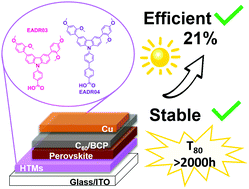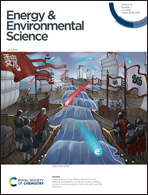Understanding the perovskite/self-assembled selective contact interface for ultra-stable and highly efficient p–i–n perovskite solar cells†
Abstract
Current perovskite solar cell efficiency is close to silicon's record values. Yet, the roadblock for industrialization of this technology is its stability. The stability of the solar cell not only depends on the stability of the perovskite material itself but also notably on its contact layers and their interface with the perovskite, which plays a paramount role. This study rationalizes the design of new molecules to form self-assembled monolayers as a hole-selective contact. The new molecules increased the stability of the perovskite solar cells to maintain 80% of their initial PCE of 21% for 250 h at 85 °C under 1 sun illumination. The excellent charge collection properties as well as perovskite passivation effect enable the highly stable and efficient devices to demonstrate the vast potential of this new type of contact in photovoltaic application.

- This article is part of the themed collection: Materials for energy storage and conversion: Chemical Science symposium collection


 Please wait while we load your content...
Please wait while we load your content...